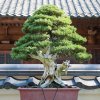So the plants on the left recieved no artistry, just shaped williy nilly. I mean just go out and buy a boxwood or juniper and make one of those in an afternoon with a hedge pruner?
I don't see any brown tips on the left. How do you know there wern't brown tips on the tree on the right, besides this exercise is not about how to prevent brown tips, this is an essay on to improve the look of your tree. Didn't we just talk about defoliating bonsai by cutting leaves in half? I have given you ample pictures and thoughts, I am always misunderstood on these forums because people are hardheaded and never step out of the box and try anything for themselves. Keep on going you have yet to convince me that bonsai is unlike hedging any other plant.
Maybe you could show me some of your pruned maples and we can see your method for gaining a nice canopy of perfectly manicured twigs. I am always open to improvement or suggestions.
Smoke i think you're misunderstood because you ask questions others don't fully understand and then don't offer a clear answer in forums like this.
As for leaves being cut in half. I would never hedge a bonsai of mine. I prefer to make precise cuts to control the direction of growth with deciduous broad leaf trees. Leaf cutting and defoliation can and are often used in conjunction however they are not the same thing. Defoliation means cutting the petiole in half on the outer canopy of a tree to let light into the inner canopy. With trees such as trident maple this can and is often applied to the entire tree once a growing season leaving it nearly leafless with only its petioles in place. At that time a tree can be wired as the branch structure is easly visible. Branches are more flexible during early summer when defoliation takes place as well. When defoliating a trident fully they will push out a slightly smaller leaf where the first 2-3 sets of internodes will be shorter. This also encourages inner shoots to push out what would otherwise die or become dormant. Once two sets of internodes are pushed out the terminal bud of each branch must be pinched to control further internode elongation and to signal the leaves on that branch to harden off and support the tree. Defoliation is also used when a trees leaves are very sick from a fungul attack or insect attack to promote a new flush of healthy leaves.
http://bonsaitonight.com/2011/06/28/defoliating-trident-maple/
http://peterteabonsai.wordpress.com/2012/06/12/the-trident-maple-project-and-summer-maple-work/
http://crataegus.com/2010/07/02/trident-maple-reworking/
Leaf cutting on the other hand does nothing to reduce internode length. It is used to let light into the canopy to promote inner growth and to redirect growth on a tree. Often a tree such as a crabapple or japanese maple will have many different sized leaves ranging from half an inch to 2-3 inches. By folding each of these 2-3 inch leaves in half down the center of the leaf and cutting it at a 45 degree angle we tell the tree that the strong branch is equal in vigor to the weaker branch with smaller leaves. The tree will then push adventurous buds in the inner canopy increasing overall density. The downside is many of these cut leaves will not be replaced this season so you will have brown edges where the leaf was cut and some off shaped leaves. It's not an eyesore as the edge of a leaf is such a tiny area.
Maintenance pruning is waiting till a tree has extended its shoots far out of its basic shape and then selectively pruning it back branch by branch till it returns to its desired shape. For trees like apple, apricot, plum, and hornbeam and others that tend to push buds from the last leaf margin before the cut, we can use this method to control the direction of growth without wiring.
Hedging is cutting away at the canopy only for shape not going branch by branch. You see a globe cut the tree to a globe, you see a triangle cut the tree to a triangle. This results in a dense canopy as we can see in topiary, but will lead to dieback of inner branches and leaves as the canopy will not be penetrable by much light.
So you asked what we saw in the two photos above. What i see is a carefully pruned bonsai on the right. On the left I see a hedged bush. It will have some brown tips its just not possible to hedge randomly and miss cutting any leaves.
To this post you'll probably say something like
The hardness of butter is proportional to the softness of bread. Or Ignorance is not bliss. Bliss is ignorance of one's ignorance.
Responses like that are what lead to misunderstanding.














